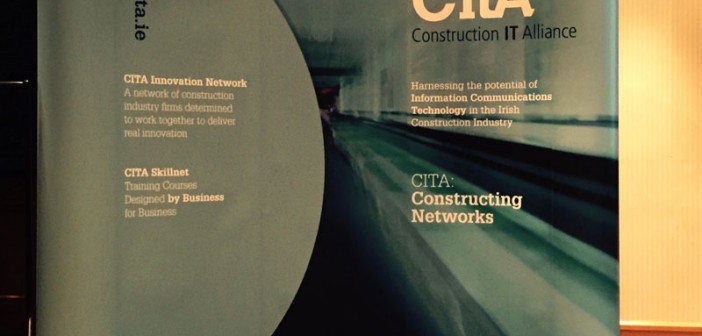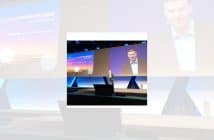After hosting its Smarter Building Series this year across the country, the latest being in Galway and Sligo, and organising fortnightly breakfast seminars in Dublin, the Construction IT Alliance (CITA) is preparing to step up a gear over the next two months.
The CITA BIM Gathering is taking place at the Gibson Hotel on Thursday and Friday November 12 and 13 when more than 300 delegates each day will have a choice of hear from in excess of 75 speakers from both at home and overseas, including some of the most eminent international keynote speakers . But before that event takes place, many of Ireland’s key experts in Construction-IT will be attending the Digital Construction Week (DCW) in London.
The DCW programme includes an Autodesk Leadership Conference on Tuesday October 20 followed by the Digital Construction Show at the Business Design Centre in Islington on Wednesday and Thursday October 21 and 22. There will be a strong Irish presence at this show, thanks to a dedicated pavilion, the Enterprise Ireland BIM Pavilion where Irish construction companies expert in BIM can offer their services to potential clients in Britain and from further afield.
As part of the Enterprise Ireland initiative, a series of keynote presentations and workshops will be hosted in the Pavilion, including: an address by CITA founding director Dr Alan Hore on ‘BIM in Ireland Today’, a presentation by Dr Shawn O’Keefe of headcount Engineering on ‘How to succeed internationally with BIM in an integrated, open world’, a discussion by Owen Sisk and Cillian Kelly of John Sisk & Son about ‘BIM for conservation and restoration projects’, an overview of ‘Advances in the prefabrication of M&E services using BIM’ by Mark Danaher of the Kirby Group, and a look at ‘Digital architects in healthcare’ by Michael Earley and Kevin Bates of Scott Tallon Walker.
“The UK government’s BIM mandate has accelerated the digital revolution in our industry, but it doesn’t stop there.” says DCW show director Ollie Hughes. “BIM is just the beginning of a new era for construction. New technologies are changing the face of the built environment.”
BIM Gathering
The CITA BIM Gathering in Dublin is very much an international event, with keynote speakers from across Europe and the United States attending. One of the gathering’s objectives is to showcase Ireland as country that has the professional skillset to design and construct modern buildings and structures using cutting-edge collaborative technologies, but it is also an attempt to learn, share and connect with representatives from the global BIM community to leverage a leaner and more efficient Irish AECO sector. This November’s event follows on from a very successful CITA BIM Gathering held in 2013.
Irish Building magazine is an official media partner of the BIM Gathering and Dr Hore said: “It’s really great to work with the Irish Building magazine. We have been really impressed with their BIM publications and online presence in recent years, which have really helped to promote CITA’s activities. Having highly respected partners like Irish Building can only broaden CITA’s relevance in the Irish building industry.”
Perhaps the ‘biggest headline’ speaker at this year’s event is Kimon Onuma, a Californian-based BIM specialist who has developed the ‘Onuma System’, a web-based BIM tool that facilitates collaborative working, particularly ‘charrettes’ or ‘BIMstorms’, intensive planning sessions where citizens, designers and others collaborate on a vision for a particular development or set of developments.
Onuma’s talk in Dublin is titled ‘Intensify architecture through the use of technology’ and he told Irish Building that this means thinking of the design and construction process as being full of valuable data. “We have to think beyond just ‘the project’ and look at the life cycle of data. Data is an asset that can be used for many things. The building industry must embrace the thinking that has made the internet and mobile devices explode – access to data, any time, any place and on any device. I bring that point of view to the building industry from Silicon Valley, the heart of the tech explosion!”
Another important speaker is Bill East, an internationally known construction management researcher who revolutionised US Army procurement while he was serving with the Corps of Engineers. He created the corp’s standard data exchange format (SDEF) protocols that ensure that private contractors working for Uncle Sam get paid on a monthly basis for the projects they are undertaking and these protocols have been in use for more than 25 years. More recently, East developed a new international standard, the Construction-Operations Building information exchange (COBie), which allows value, and profit, to be extracted from the project handover process.
From this side of the Atlantic, Ilka May, an associate director at Arup, will survey efforts to bring in a pan-European Level 3 BIM mandate for certain categories of construction project. May was recently appointed chair of a German Industry Association for Digitisation of Design, Building and Operations, will outline how lack of uniform progress on BIM across Europe to date may prevent an EU-wide mandate being introduced for fear such a requirement could be interpreted as a restriction on trade.
Onumu says he believes that the US is lagging behind Europe in bringing in standards, but he added: “Even though I have been involved with BuildingSMART standards for years, from the beginning, I take a practical view. Standards don’t mean anything unless they can get implemented and get industry support. Making them too complex or theoretical is not good. Many of the standards discussions often tend toward the theoretical!”
Other headline speakers include: Dr Arto Kiviniemi, a leader of the BuildingSMART movement, who is Professor of Digital Architectural Design at the University of Liverpool, Dr Claire Penny, a BIM Solution Leader in IBM’s internet-of-things business unit; Dr Frédéric Bosché, a 3D point cloud data processing specialist who is assistant professor at the School of Energy, Geoscience, Infrastructure and Society at Heriot-Watt University; and David Philp, director of BIM for EMEA and India with AECOM, the New York stock exchange listed technical and management consultancy giant.
Themes
Conference papers will be presented and discussed in workshop settings, organised under a number of key themes.
“One of the major topics for examination will be cultural change management,” says Dr Hore, who is assistant head of the School of Surveying and Construction Management at DIT. “BIM requires significant changes in the way construction businesses work at almost every level within the building process. It requires not only learning new software applications but also how to reinvent the workflow, how to train staff and assign responsibilities. BIM represents a sea change to the design process and how we prepare firms for this shift has everything to do with future success. One of the biggest obstacles to BIM is the misunderstanding amongst directors and executives that BIM is just a piece of software used by technical people. BIM is a completely different process and understanding the cultural changes that are required and how to communicate these processes at the boardroom tables is something every executive and business leader will have to deal with. If BIM is to be the catalyst in reforming the Irish construction sector, the industry must learn by looking at other jurisdictions where there has been a cultural shift and new innovative ways of process change management adopted.”
Another area that will receive close scrutiny is the increasing use of off-site construction and pre-fabrication, which is often done using lean construction principles. Dr Hore said: “On site construction is costly, wasteful and poses higher health and safety risks. BIM is beginning to change the way one builds, the way buildings look, the way they function and the way buildings are maintained and managed. BIM can be used effectively to address the conceptual design, product and process design elements of the Lean Construction principles. BIM is in the unique position to play a major part in the reduction of waste through the fostering of better off-site fabrication techniques. This can result in fewer accidents, more efficient schedules and an improvement in logistics planning, reduce hours worked onsite and using new materials and equipment to create a safer work environment, among other initiatives.”
Crucially, one of the most important themes of the conference for BIM advocates concerns ways of driving demand for BIM. Dr Hore said: “BIM offers so many advantages through the complete life-cycle of a building that we have to ask – why are more clients not demanding BIM? If BIM is to really take off, clients, the end users, have to understand what it is and have to want to specify it when they are commissioning projects.”
Lastly, the BIM Gathering will look at BIM training initiatives and how best to familiarise under-graduate and post-graduate students about the potential of building information modelling. Dr Hore said: “As an educator for nearly 30 years I can see that we are still preparing our future graduates to work in a fragmented ad adversarial industry. It is high time that we started to wake up to the reality that information is the fuel of our industry. Without high quality, prompt, accurate and reliable information we will continue to create poorly performing buildings and end up in the courts. We need to embrace the digital world and all it has to offer, we need to work smarter and become a leaner fitter industry simply to survive.”
[rev_slider CITA]




